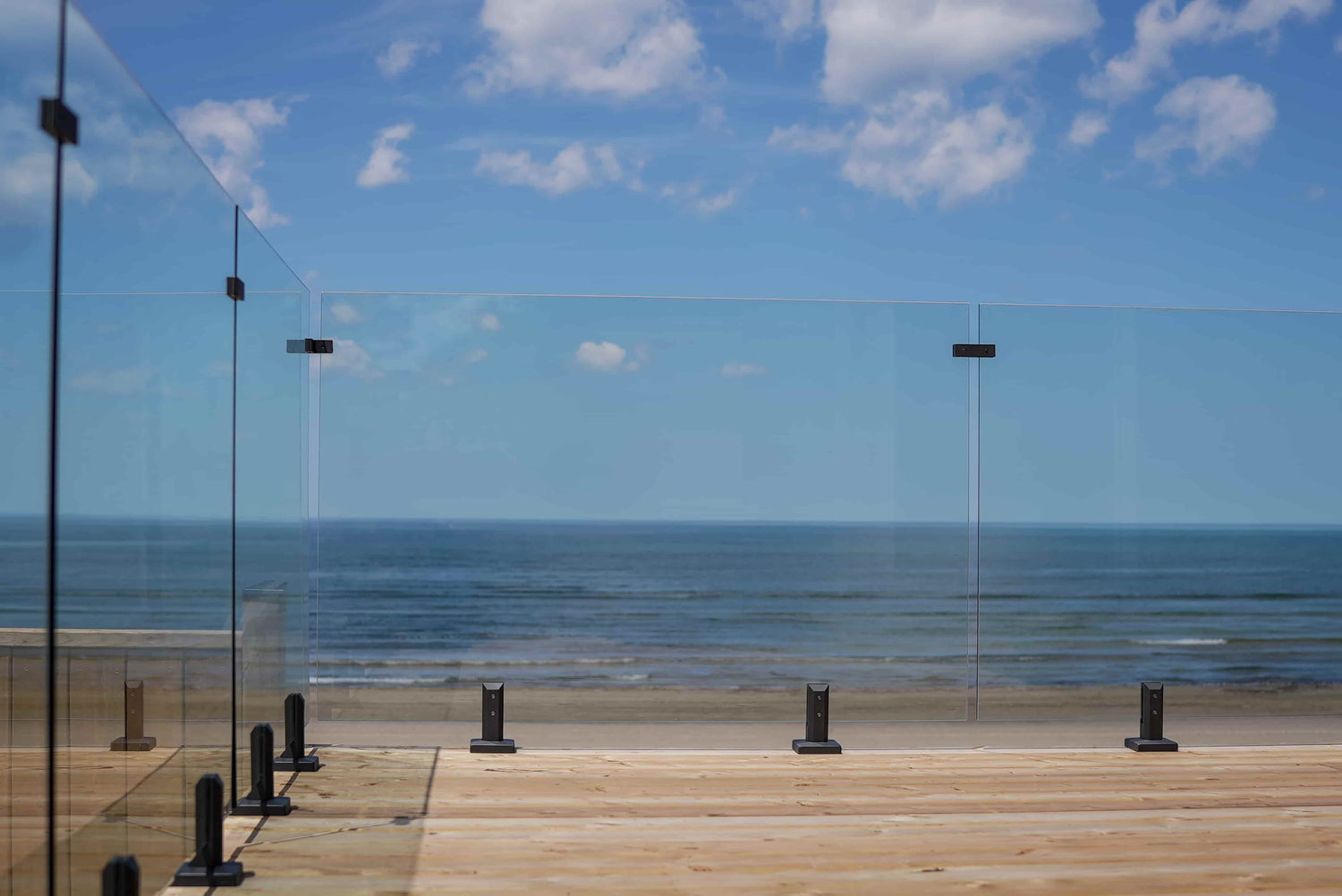Ontario Building Code for Glass Railings

The Ontario Building Code for glass railings is an essential regulation that ensures the integrity and safety of buildings and construction projects within this province. This guideline regulates the conception, construction, operation, and maintenance of private and public buildings to protect life and property.
Glass railings installed on decks, balconies, rooftops, ramps, and stairways can significantly enhance the appearance of indoor and outdoor spaces. However, installing and using glass railings is heavily regulated as improper deployment can pose major safety risks, especially when adequate maintenance is lacking.
This guide highlights the safety regulations for Ontario glass railings that homeowners and contractors need to know to guarantee the safety of buildings.
General Building Code Overview for Ontario
The Ontario Building Code, also known as OBC, first came into use in 1975, superseding all municipal regulations governing building design, construction methods, material selection, and safety procedures in this province. Since then, this guideline has gradually undergone several reviews, incorporating changes in safety regulations and innovations in construction technology.
The OBC has several benefits, including the following:
- It ensures the design and installation of glass railings, which guarantees the safety of users.
- It ensures the structural design of glass railings can withstand many loads.
- It ensures the glass planes used in railings are of the required thickness and quality to minimize the likelihood of breakage.
- It ensures glass railings adhere to all other accessibility requirements stated in the OBC.
The Ministry of Municipal Affairs and Housing is the regulatory body responsible for supervising and enforcing the building code within Ontario. It uses the OBC to ensure all construction projects conform to standards that ensure sustainability and safety.
Structures That Require Guard Railings
Many spaces that rise above the ground require guard railings. In particular, decks, terraces, landings, and balconies 610 mm (24 inches) above a base or floor require a guard railing.
Similarly, stairways with more than 3 risers require a handrail or guard railing.
Glass Railings Specific Regulations
The Ontario Building Code provides specific glass railing requirements that ensure the safety and durability in residential, commercial, and public buildings. Architects and engineers involved in construction projects must consider these compliance guidelines for glass specifications and railing height requirements.
Glass Specifications
The specifications of glass railings include the thickness, height, composition, color of the panel, and more. These requirements are essential for minimizing the likelihood of glass panel breakage and injury to people who may fall due to failed or broken glass.
Glass Panel Quality
The glass panels used for railings must be free of cracks and chips before and after installation.
Glass Panel Thickness
The glass panels used for railings must have a thickness capable of withstanding different impacts and loads based on the CAN/CGSB 12.1-2017 certification. Therefore, the thickness of glass used depends on the location, type, and function of the railing, ranging from 12 mm (0.5 inches) and above. As such, a residential glass railing must have a thickness of at least 12 mm (0.5 inches).
Glass Panel Composition
Glass railing compliance guidelines require tempered panels between the top and bottom rails. Tempered glass is used for residential buildings as the panels are less likely to shatter due to the heat treatment it undergoes during production.
In some commercial and public buildings, heat-strengthened laminated panels are used for railings. The multiple layers of panels prevent the glass from shattering when it breaks.
Glass Panel Color
The Ontario Building Code does not specify color requirements for glass railings. As such, the panels can be of any color as long as the glass selected meets all performance and safety regulations.
Railing Height Requirements
The glass railing height requirements deal with the building safety compliance guidelines for building use and building type. Glass panels must reach a minimum height that prevents people from falling.
For this reason, the height safety regulations require a glass railing system to be at least 914 mm (36 inches) tall. A typical glass railing should not pass anything below and above the glass.
As such, the space between each panel should not exceed 100 mm (4 inches) for the safety of children who may want to stick their heads.
Single Residential Family Homes
- Landings, decks, or balconies with a drop less than 5 ft 11 inches must have railings of 914 mm (36 inches).
- If the drop is more than 5 ft 11 inches, the railings must be 1067 mm (42 inches).
- Stairway railings must be 914 mm (36 inches).
Multi-residential Family Homes and Commercial Buildings
- Landings, decks, or balconies must have railings of 1067 mm (42 inches).
- Stairway railings must be 914 mm (36 inches).
Pool Enclosures
- Glass railings for pools must have a height of 1219 mm (48 inches) to make them non-climbable and secure.
- To increase safety, all gates should have self-closing mechanisms.
Installation and Safety Tips
The longevity and safety of any glass railing directly connect with the quality of installation. Below are some installation and safety tips to consider.
- Glass railing installation must only be performed by a certified professional installer with extensive experience working with glass to guarantee safety and quality finishing.
- Contractors should only use tempered glass or heat-strengthened laminated glass for railing to prevent unexpected glass breakage from imperfections.
- Anchoring glass railings to building structures limits the likelihood of panel detachment. This can be achieved through the appropriate use of support systems, including brackets and fasteners capable of handling different design loads as stipulated in the compliance guidelines.
- After installation, regular inspections must occur to ensure the functionality and safety of glass railings. Once any loose fittings, cracks, or damage are detected, appropriate maintenance actions must be taken to prevent accidents.
Comparison with National Standards
The Ontario Building Code and the National Building Code of Canada (NBC) are similar regulations. In particular, both building safety regulations highlight the need for structural integrity and safety of glass railings when choosing the composition, height, and thickness of glass.
Yet, Ontario glass railing requirements include additional guidelines specific to local building practices and conditions.
Conclusion
The Ontario Building Code for glass railings is crucial to ensure safety and functionality. As such, balconies, landings, and staircases require railings based on predetermined glass panel requirements and height specifications.
Installing a functional glass railing requires strict adherence to the OBC and NBC regulations, which provide local and national guidance to installers. In addition, both building safety compliance guidelines ensure structural integrity and safety glass railings without forgoing aesthetics.
FAQs for Ontario Building Code
What is the railing code in Ontario?
The OBC requires decks, ramps, landings, and all raised platforms that reach a certain height above the ground to have guard railings. It also provides detailed guidelines regarding the height and quality of materials used for installing railings.
Do glass railings need to be tempered?
All glass railings in Ontario must be tempered glass to prevent injury from cracks or breakage. Some commercial and public buildings can use heat-strengthened laminated glass panels for railings. However, any glass used must conform to the CAN/CGSB 12.1-2017 certification.
How high does a glass railing need to be?
Glass railings must be high enough to prevent users from falling over. Single-family homes, commercial buildings, and pool enclosures glass railings must reach a height of least 914 mm (36 inches), 1067 mm (42 inches), and 1219 mm (48 inches), respectively.
What is the thickness of glass railings?
The thickness of glass railings starts at 12 mm (0.5 inches), which is the minimum requirement for all residential buildings.
Let customers speak for us

Glass Railing Near You
Discover how The Glass Railing Store has been delivering exceptional service to our customers, thanks to our dedicated and knowledgeable team and their love our glass railing products.







